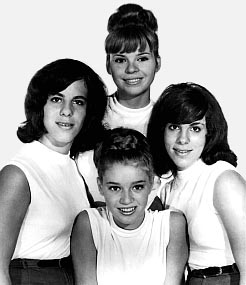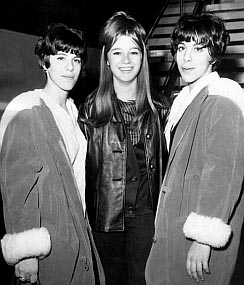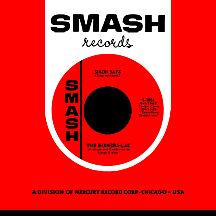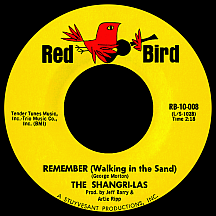THE SHANGRI-LAS
The visual impression made by The Shangri-Las sharply contrasted every one of the female singing groups that existed prior to the mid-1960s. Though they didn't seem so different from the pack at first, once popular the girls began wearing dark jackets and black vests with white pants, mini-skirts, "catsuits" with ruffled blouses and go-go boots (lots of B&W!), outfits that bordered on schoolgirl uniforms and, later, summery pastel capris - counterculture dress-up at odds with the casual frocks and occasionally stylish gowns associated with the images of many other girl groups. The Shangri-Las themselves didn't singularly create the fashion upheaval that influenced the singers that came immediately after them or even moreso the female rockers of later generations; it was just part of the plan at Red Bird Records to position them as a unique act, both musically and visually. You can thank Shadow Morton's darkly creative disposition for the music side of the equation.
The four girls who named themselves after the mythical setting of James Hilton's best-selling 1933 novel Lost Horizon began singing together while attending Andrew Jackson High in the Cambria Heights neighborhood of Queens, New York. Twins Mary Ann Ganser and Marguerite Ganser (nickname: Marge), age 15 in 1963, joined Elizabeth Weiss (nickname: Betty), who was 16, and her 14-year-old sister Mary Weiss, who ultimately stepped to the forefront as the act's emotionally-charged lead. After performing at some school dances and local shows, New York producer Artie Ripp offered them a limited contract with his relatively new Kama Sutra Productions. "Simon Says," backed by the mostly-instrumental "Simon Speaks," penned by struggling songwriter Tony Michaels, was recorded live at one of their performances. Set to a Bo Diddley-type beat, the vocals came off as rather shrill and amateuristic, yet Ripp managed to get Mercury Records to release it on Smash (using an odd spelling, The Shangra-Las) in late 1963; predictably, it failed to generate any interest.
A studio recording of producer Michaels and Joe Monaco's "Wishing Well" was much stronger, Mary's primary vocal suggesting the foursome had the necessary chops to compete in the Beatles-saturated music environment of early 1964. Scepter Records picked this one up and issued it on the Spokane label; though it suffered the same fate as the first single, word was gradually trickling out in the New York boroughs about this new group. Meanwhile, former Atlantic Records producing and songwriting masterclassmen Jerry Leiber and Mike Stoller, along with George Goldner and other investors, started Red Bird (an offshoot of the previously-established Daisy and Tiger labels), hitting pay dirt right off the bat with "Chapel of Love," a number one hit in June '64 for The Dixie Cups, a girl group from New Orleans that had relocated to N.Y.
Richmond, Virginia-born George Morton, who'd grown up on the streets of Brooklyn singing with at least one doo wop outfit, had made the acquaintance of Ellie Greenwich (one of the composers of "Chapel") in the late '50s. Seeing her as an "in" to the business, he paid a visit to the Red Bird offices about five years later, making claims of being an experienced songwriter (he wasn't) who made hit records (he hadn't...yet). Jeff Barry (Ellie's hubby and co-writer of the Dixie Cups' smash) called Morton's bluff, challenging him to write a hit song. Morton went him one, or three, better: he booked a small studio in Long Island, where he lived at the time, hired a band and put the word out among friends that he was looking for an artist to record a demonstration record. Checking out the Shangri-Las at a show they were doing, he threw a dubious offer their way, they took it, and agreed to meet him at the studio that weekend.
The song swirling around in Shadow's maze-like mind was "Remember (Walking in the Sand)," which dealt with a rejected-and-heartsick young girl ('Oh, no...oh, no...oh, no, no, no, no, no'...what'cha think of those lyrics?) agonizing over memories of love lost. Heading back to Red Bird with a tape of the recording, he found Leiber, Stoller, Barry and the staff receptive; they decided to rework the song with the girls Morton had used on the demo, handing it off to staff arranger Artie Butler, who did the arrangement with Barry producing and Morton, who came up with the idea to add sound effects of seagulls, manning the sidelines. Mary, a very good singer who acted the part of the disillusioned protagonist with conviction, impressed everyone in the room; the other three supplied harmonic backup that suited the tone of the production. No time was wasted on getting it out to the public and the single spent most of September and October 1964 in the top ten.

As for Morton's nickname, the story is that he'd shown up at Red Bird shadow-like, out of nowhere; George fancied the idea and adopted it as his professional moniker. Attempting to take "teen angst" themes to another level, he constructed dramatic scenarios of heartbreak and/or parental disdain with bolder-than-usual stories of post-adolescents often paying a drastic price for yielding to their urges; Shadow's themes were serious, even fatalistic, but with a movie-like sense of romanticism that encompassed the dreams - and nightmares - of many teenage girls. Leiber and Stoller, acknowledging his raw talent, provided plenty of guidance; it had all been done before, yet Morton tackled the subject matter with an intensity previously untested and the Shangri-Las, Mary in particular (whom Shadow considered on a par with the best movie actresses), became his willing courier. Once established with the first hit, the image makeover began; the wild outfits made them look tough and streetwise (unusual fashion appeared to be a theme with Red Bird acts; labelmates the Dixie Cups went in a whole 'nother direction, at one point sporting a liberally altered American Indian look).
Betty seemed more apprehensive than the others at the prospect of performing for large audiences; suddenly the Shangri-Las were a trio in public while remaining a quartet on recordings. "Leader of the Pack," a collaboration of Jeff, Ellie and Shadow, followed on the heels of "Remember." A bold, over-the-top narrative of a young girl in love/lust with a leather jacketed Wild One/Brando-type biker named Jimmy, it surely came off as a frightening prospect to parents/guardians. A motorcycle was wheeled into the studio to create the sound effect; the story of love found then lost ('Betty, is that Jimmy's ring you're wearing?...Mm-hmm...') ended with the bad boy shedding a tear before dying in a rainy night crash, and there you have another in a long line of hit "death" songs, perhaps the greatest of all. The record was number one in America by the end of November.
Two parodies of the song emerged, the first by the Shangri-Las themselves with help from a few "older generation" TV stars. The group, minus Betty, appeared on CBS-TV's I've Got a Secret just before the single topped the charts, performing the song as part of a bizarre skit that was quite a departure from the regular format of the popular personality-driven game show. Singer and Broadway star Robert Goulet played the biker role tongue-in-cheek, on a motorcycle, while the trio lip-synced their hit; host Steve Allen and panelists Betsy Palmer, Bess Myerson and Henry Morgan watched bewilderedly while gleeful younger members of the studio audience gasped and applauded. The other parody came in the form of an inane novelty record, "Leader of the Laundromat" by male group The Detergents ('Who's that bangin' on the piano?...I don't know...'), that perplexingly made the top 20 in January 1965.
The Shangri-Las took Morton's "Give Him a Great Big Kiss" into the top 20 in early '65. A more lighthearted effort than its predecessor while retaining a hint of rebelliousness ('Well, I hear he's bad...Mmm, he's good-bad, but he's not evil!'), the song still put forth a perception they were delinquents of some sort, an incorrect assessment along the lines of someone thinking an actor is, in real life, the same person as the character he plays. Betty rejoined at some point that year but Mary Ann stopped touring for personal reasons and the group remained a trio (sometimes it was blonde Mary flanked by twin brunettes, other times the non-twin sisters with one darker-haired member, leading to confusion); this musical-chairs-like routine went on for a few years with the quartet often reduced to, but never less than, a trio. Other 1965 singles met with a degree of resistance. A faux-live rehash of The Chantels' great 1958 hit "Maybe" didn't quite work. "Give Us Your Blessings," which had been a minor hit for Ray Peterson two years earlier, confronted forbidden romance head-on, ended in grisly fashion with a rainy-night car wreck, and reached the top 40 in June.

"I Can Never Go Home Anymore" makes perhaps the most powerful statement of all the Shangri-Las' productions. Morton and Barry's mini-drama concerns a mother-and-daughter spat, followed by the girl running off with a young man, then as a result of her less-than-mature decision, the daughter has to cope with her mother's death. Overly dramatic? Sure, but lyrics such as '...she grew so lonely in the end...angels picked her for their friend...' pack a wallop. Artie Butler's powerful arrangement and Mary's truly despondent portrayal of the character connected across the board and put the group back in the top ten in December.
J.J. Jackson and Sidney Barnes, who'd specialized in writing girl-centric numbers, incorporated the Civil War song "When Johnny Comes Marching Home" into "Long Live Our Love," a faraway-soldier-boy kind of thing that was the group's sixth and final top 40 hit during the winter of 1966. "He Cried," a female-adjusted rendition of the 1962 Jay and the Americans hit "She Cried," was a good fit for the Shangri-Las' established style. With "Past, Present and Future," Leiber, Butler and Morton dared to confront the forbidden subject of rape and its effect on a teenage girl's psyche set to the strains of Ludwig Van Beethoven's 1801 masterpiece "Moonlight Sonata." The victim as portrayed by Mary loses confidence, certain that falling in love will '...never happen again.'
A number of business (and artistic) conflicts led to the dissolution of Red Bird and its sister label Blue Cat towards the end of 1966. Morton took the girls back to Mercury, where "Simon Says" had signaled their coming; 1967's "The Sweet Sounds of Summer," a lighter pop song with a mild psychedelic feel, wasn't the hoped-for comeback record...then the sweetly sentimental "Take the Time" abruptly marked the end for the group as recording artists. Morton moved on to newer projects; he produced Janis Ian's 1967 hit, the Shangri-Las-like "Society's Child," and several soul-songs-turned-rock-epics by Vanilla Fudge. Members of the Shangri-Las parted ways by the end of the decade.
Despite their progressive edge, The Shangri-Las weren't taken all that seriously by critics of the era, but with time their influence and importance has become obvious. The drama and tragedy of their music, unfortunately, extended to the lives of the twin sisters. In 1970, Mary Ann Ganser died at just 22 years of age; for some time she had been suffering from seizures related to encephalitis. Marge Ganser succumbed to breast cancer in 1996. Betty Weiss has focused on marriage and family, though in the 1970s and '80s she occasionally joined Marge and Mary to perform under the group's name. Now as far as Mary Weiss goes, she has continued carrying the torch, recording as a solo artist and performing frequently, doing material old and new. If you ever get a chance to meet Mary, tell her she's a rock star...one of the best! Because that's exactly what she is!
NOTABLE SINGLES:
- Simon Says - 1963
as the Shangra-Las - Wishing Well - 1964
- Remember (Walking in the Sand) - 1964
- Leader of the Pack - 1964
- Give Him a Great Big Kiss - 1965
- Maybe - 1965
- Out in the Streets - 1965
- Give Us Your Blessings - 1965
- Right Now and Not Later - 1965
- I Can Never Go Home Anymore /
Bull Dog - 1965 - Long Live Our Love /
Sophisticated Boom Boom - 1966 - He Cried - 1966
- Past, Present and Future - 1966
- The Sweet Sounds of Summer - 1967
- Take the Time - 1967



